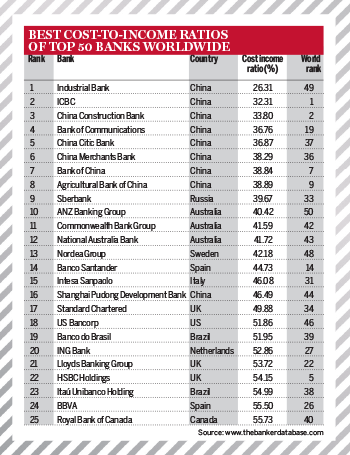China dominates the list of best-performing banks for cost-to-income ratios, accounting for each of the top eight. This table focuses only on the 50 largest banks worldwide, as there are some quirks further down the ranking, including asset managers with a banking licence that tend to be stark outliers.
Philip Alexander reports on the full results of The Banker’s Top 1000 World Banks ranking 2014, in the story Top 1000 World Banks 2014: Back on track?
Given the network size of many Chinese banks, this healthy performance mostly reflects the very strong earnings generated in China at present. Many are state-owned banks that would not normally be considered profit maximisers or ruthless cost-cutters, but the supportive environment for income offsets the sheer scale of banking in the world’s most populous country.
The same is true for Russia’s Sberbank, the highest non-Chinese bank in the list. Sberbank is also state-owned, and has the largest branch network in the world. It is relied upon to provide banking services to many Russians in the country’s more remote areas not served by the private sector. Yet very high profitability, including a 32% return on capital, keeps the cost-to-income ratio low.
Among developed markets, Australia is clearly the most effective at cost control, holding the top three spots for banks outside emerging markets. Return on capital is very high in Australia by developed market standards – 25% to 30% in many cases. As one would expect, staff costs are significantly higher in Australia than in emerging markets. The Banker Database shows that Commonwealth Bank, Australia’s largest, spends $103,630 on each member of staff, whereas ICBC, the largest in China, spends just $38,365. Consequently, the control of other costs at Australian banks is all the more impressive.
Naturally, where banks in developed markets have large operations in lower cost, higher growth emerging markets, this can boost their cost-to-income ratios. Australian banks are active across south-east Asia. Two UK banks, Standard Chartered and HSBC, earn the majority of their revenues from emerging markets – mainly Asia-Pacific and the Middle East, plus Africa in the case of Standard Chartered.
Although Africa may be a comparatively underpenetrated banking market, costs are relatively high – close to 60% for many of the region’s largest banks. By contrast, in Bangladesh, where both HSBC and Standard Chartered have subsidiaries, the ratio is less than 30%. The high population density in Asia compared with many parts of Africa may well play a factor in helping to generate higher revenues for lower costs.
The other country that performs well in this list is Brazil, with two Brazilian banks featuring in the best banks by cost-to-income ratio ranking. Banco Santander, the largest bank in Spain, is also benefiting greatly from its large Brazilian subsidiary, offsetting the weakness of revenues in its domestic market. Santander Brasil has a cost-to-income ratio that is more than six percentage points lower than the group ratio. BBVA does not have a Brazilian subsidiary, but its Mexican operation Bancomer provides a similar benefit, with a cost-to-income ratio more than 13 percentage points lower than the group figure. In Italy, two of Intesa Sanpaolo’s largest foreign subsidiaries – in Slovakia and Serbia – also support its group cost-to-income ratio.
This table also bears testament to the success of certain bank turnaround operations. Two banks that needed state support during the financial crisis, Lloyds and ING, now perform relatively strongly in terms of cost-to-income ratios. Other banks, such as RBS and Commerzbank, which have not yet emerged from their process of strategic realignment, have much higher ratios. Certain business lines are also particularly expensive to run, especially those focused on private banking. The Swiss banks Credit Suisse and UBS, which specialise in private banking and wealth management alongside investment banking, both have cost-to-income ratios in excess of 80%.










